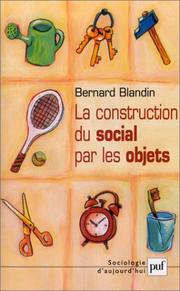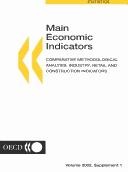| Listing 1 - 10 of 1627 | << page >> |
Sort by
|
Book
ISBN: 1784065536 Year: 2019 Publisher: London, England : ISTE Editions,
Abstract | Keywords | Export | Availability | Bookmark
 Loading...
Loading...Choose an application
- Reference Manager
- EndNote
- RefWorks (Direct export to RefWorks)
Book
Abstract | Keywords | Export | Availability | Bookmark
 Loading...
Loading...Choose an application
- Reference Manager
- EndNote
- RefWorks (Direct export to RefWorks)

ISBN: 2130527833 9782130527831 Year: 2002 Publisher: Paris: PUF,
Abstract | Keywords | Export | Availability | Bookmark
 Loading...
Loading...Choose an application
- Reference Manager
- EndNote
- RefWorks (Direct export to RefWorks)
Consumer goods --- Consumer goods --- Consumption (Economics)
Book
ISBN: 1504456831 Year: 2019 Publisher: New York, New York : IEEE,
Abstract | Keywords | Export | Availability | Bookmark
 Loading...
Loading...Choose an application
- Reference Manager
- EndNote
- RefWorks (Direct export to RefWorks)
Information for use is a part of any type of product it supports. Confusing product information and inadequate instructions are major sources of frustration for consumers and skilled workers. Defective information can pose a risk of harm or loss, leading to prosecution or liability claims against the supplier or brand owner. This document gives principles and general requirements for conveying information to users that are as applicable to complex and safety-critical systems (e.g. industrial plants), as they are to simple consumer products (e.g. a can of paint), to software, and to specialized testing equipment. Information for use is needed for anyone (skilled and unskilled) who encounters a product for the first time: whether to assemble from a kit, install, operate, maintain, or dispose of it.
Book
Year: 1995 Publisher: [Netherlands]: [éditeur inconnu],
Abstract | Keywords | Export | Availability | Bookmark
 Loading...
Loading...Choose an application
- Reference Manager
- EndNote
- RefWorks (Direct export to RefWorks)
Book
Year: 1689 Publisher: Dublin, : Printed by Andrew Crook the assignee of Benjamin Tooke printer to the King's most excellent Majesty; and are to be sold at his Majesties printing-house on Ormonde-Key,
Abstract | Keywords | Export | Availability | Bookmark
 Loading...
Loading...Choose an application
- Reference Manager
- EndNote
- RefWorks (Direct export to RefWorks)
eebo-0018
Consumer goods --- Ireland --- History
Book
ISBN: 3631725752 Year: 2017 Publisher: Frankfurt am Main, [Germany] : PL Academic Research,
Abstract | Keywords | Export | Availability | Bookmark
 Loading...
Loading...Choose an application
- Reference Manager
- EndNote
- RefWorks (Direct export to RefWorks)
Dieses Buch setzt sich kritisch mit der Umsetzung der Verbrauchsgüterkaufrichtlinie 99/44/EG vom 25. Mai 1999 ins polnische Recht auseinander. Dabei untersucht es die Richtlinienkonformität des entsprechenden Umsetzungsgesetzes vom 27. Juli 2002. Ausgang der Argumentation ist der Beitritt Polens in die Europäische Union 2004. Eine der schwierigsten und herausforderndsten Aufgaben im Rahmen des Beitrittsprozesses war für Polen die Anpassung der innerstaatlichen Rechtsvorschriften an die Richtlinienvorgaben der EU. Die Umsetzung der unterschiedlichen EU-Richtlinien zwecks Schaffung eines Mindestsockels an gemeinsamen Vorschriften führte zu einer umfangreichen Umgestaltung des polnischen Zivilrechts mit teilweise weitreichenden Folgen für den Rechtsanwender.
Book
Year: 1689 Publisher: Dublin, : Printed by Andrew Crook the assign of Benjamin Tooke printer to the King's most excellent Majesty; and are to be sold at his Majesties printing-house on Ormonde-Key,
Abstract | Keywords | Export | Availability | Bookmark
 Loading...
Loading...Choose an application
- Reference Manager
- EndNote
- RefWorks (Direct export to RefWorks)
eebo-0018
Consumer goods --- Ireland --- History
Book
Year: 1976 Publisher: Cambridge, Mass. National Bureau of Economic Research
Abstract | Keywords | Export | Availability | Bookmark
 Loading...
Loading...Choose an application
- Reference Manager
- EndNote
- RefWorks (Direct export to RefWorks)
It is the price behavior in primary manufacturing industries and its implication for general inflation that is the subject of this paper. The industries comprising primary manufacturing are quite diverse. They differ with respect to labor and capital intensity, domestic and international market structure and the markets that they supply -- consumer goods manufacturing, producer goods manufacturing and construction. To shed light on the price behavior of the group as a whole it is necessary to disaggregate the total somewhat. In this study they are broken down into eight separate industries. The exact definition of each, both in terms of 4-digit SIC industry and I-0 cell is available on request. In general, the eight separate industries consist of the primary manufacturers producing (1) textiles, (2) wood, (3) paper,(4) chemicals, (5) fertilizers,(6) stone, clay and glass, (7) iron and steel, and (8) nonferrous metals.

ISBN: 1280006048 9786610006045 9264196463 9264197265 Year: 2002 Publisher: Paris : OECD Publishing,
Abstract | Keywords | Export | Availability | Bookmark
 Loading...
Loading...Choose an application
- Reference Manager
- EndNote
- RefWorks (Direct export to RefWorks)
This publication compares key aspects of statistical methodologies used by OECD member countries in the compilation of industry, retail and construction indicators. It focuses on data comparability in the context of international statistical guidelines and recommendations published by the OECD and other international agencies. This publication complements two other OECD publications, Main Economic Indicators (MEI), and Main Economic Indicators: Sources and Definitions.
Consumer goods. --- Marketing. --- Retail trade.
| Listing 1 - 10 of 1627 | << page >> |
Sort by
|

 Search
Search Feedback
Feedback About UniCat
About UniCat  Help
Help News
News